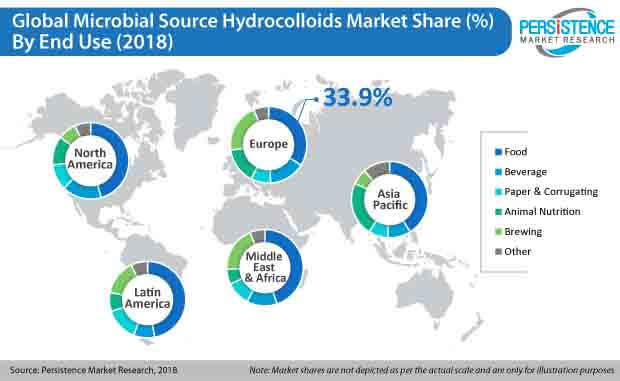Introduction
Microbial source hydrocolloids are a type of hydrocolloids derived from microbial sources such bacterial polysaccharides. These can be obtained by fermenting bacterial polysaccharides.
Microbial source hydrocolloids are of various types such as xanthan gum, gellan gum, curdlan, dextran, pullulan, and scleroglucan. Microbial source hydrocolloids are water soluble polysaccharides. Microbial source hydrocolloids were initially used as substitutes for gelling agents in order to replace agar in culture media, which is used to grow various microorganisms. Later, the usage of microbial source hydrocolloids expanded to include food products such as food additives.
Microbial source hydrocolloids are widely used as emulsifiers, thickeners, and stabilizers. They are also used as substitutes for gelatin in the manufacturing of vegan candies and confectioneries. Microbial source hydrocolloids are also used in plant-based milk products, and are listed as an ingredient in soy milk.
The different product types of microbial source hydrocolloids analyzed in the report are:
- Xanthan Gum
- Curdlan
- Gellan Gum
The various applications of microbial source hydrocolloids analyzed in the report are:
- Thickeners
- Stabilizers
- Emulsifiers
- Gelling
- Coating
- Texturizing
The various end uses of microbial source hydrocolloids analyzed in the report are:
- Bakeries & Confectioneries
- Meat & Poultry
- Sauces & Dressings
- Beverages
- Dairy Products
- Others

Manufacturers are Focused on Increasing Business Horizons for Microbial Source Hydrocolloids
- Manufacturers of microbial source hydrocolloids are focusing on expanding their business horizons, which will help enhance production capacity in order to meet the increasing demand for microbial source hydrocolloids in various regions.
- In April 2016, CP Kelco expanded its production capacity of gellan gum and pectin at its production plant in China. In addition, the company established a global innovation center for hydrocolloids in China.
- In October 2016, CP Kelco expanded its presence in the Middle Eastern market by setting up a new laboratory and office in Dubai, UAE, to enhance it production capabilities so as to serve customers in the Middle East, Africa, and Turkey.
Increasing Adoption of Microbial Source Hydrocolloids by Consumers Owing to High Dietary Fiber Content
- There has been an increase in the adoption of microbial source hydrocolloids, owing to the presence of high dietary fiber content, which helps in healthy bowel movement and digestion. Microbial source hydrocolloids can benefit patients suffering from irregular bowel movement and constipation. There has been an increase in the number of manufacturers focusing on securing regulatory clearances for microbial source hydrocolloids.
- In November 2016, EFSA (European Food Safety Authority) concluded that, gum Arabic can be included in FibreGum, a product from Nexira International, as a dietary fiber for consumers.
Developing Countries Becoming Key Target Markets for Microbial Source Hydrocolloid Manufacturers
- Developing countries in Latin America and Asia are becoming the target markets for microbial source hydrocolloid manufacturers. This is due to the growing benefits of microbial source hydrocolloids.
- In December 2016, Cargill opened an innovation center in Shanghai, China. The objective of this expansion was to focus on taste and flavor, food ingredients, etc., as per consumer demand.
Companies Increasingly Investing in R&D, thus Expanding the Growth of the Microbial Source Hydrocolloids Market, Globally
- Microbial source hydrocolloid manufacturers are focusing on regional expansion in order to leverage opportunities and expand their consumer base through strategic agreements, launch of new products, and various partnerships.
- In September 2016, Kerry Food Ingredients Cebu Inc., a Philippines-based company, was acquired by W Hydrocolloids. It acquired the seaweed processing facility. This acquisition will help meet various consumer requirements.
Growing Consumption of Convenience Foods to Drive Growth of the Microbial Source Hydrocolloids Market
- There is increased usage of microbial source hydrocolloids in various ready-to-mix and eat products such as dessert mixes, curries, and bakery products. The gelling, binding, and thickening properties of microbial source hydrocolloids vary according to the ratio of amylose and amylopectin. Various other techniques allow for these ratios to be tweaked according to requirements. Thus, microbial source hydrocolloids find application in convenience food products.
Taxonomy of Microbial Source Hydrocolloids Market
| Attribute |
Details |
| By Product Type |
- Xanthan Gum
- Curdlan
- Gellan Gum
|
| By Application |
- Thickeners
- Stabilizers
- Emulsifiers
- Gelling
- Coating
- Texturizing
|
| By End Use |
- Bakeries & Confectioneries
- Meat & Poultry
- Sauces & Dressings
- Beverages
- Dairy Products
- Others
|
To know more about delivery timeline for this report
About Author
Amol Patil
Senior Associate Consultant
Amol is a Senior Associate Consultant and brings profound experience across multiple facets of the food and beverage domain. With over three years of expertise in food additives, dietary supplements, beverages, and food processing, he has consistently delivered exceptional insights through primary and secondary research for Fortune 500 clients. His strong research acumen enables him to identify emerging market opportunities, analyze industry trends, and explore technological developments shaping the food and beverage landscape.
Read More →
Companies Covered in This Report
- CP Kelco
- DowDuPont Inc.
- Cargill, Inc.
- Ingredion Inc.
- Archer Daniels Midland Company
- Koninklijke DSM N.V.
- Ashland Global Holdings Inc.
- Fuerst Day Lawson Limited
- Nestlé Health Science S.A.
- Jungbunzlauer Holding AG
- Deosen USA Inc.
- Tate & Lyle PLC
- Lubrizol Corporation
- Fiberstar, Inc.
- Euroduna Food Ingredients GmbH
- B&V SRL
- Hawkins Watts
- Compañía Española de Algas Marinas S.A.
- Hispanagar, S.A
- Others.

